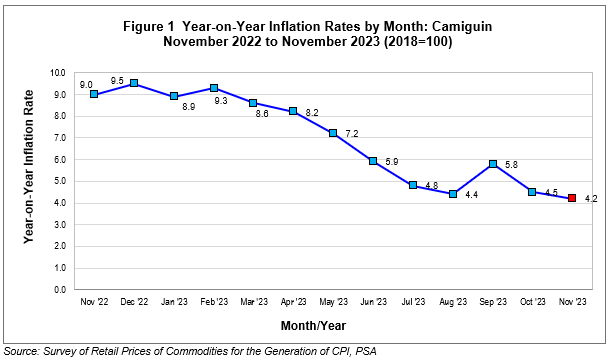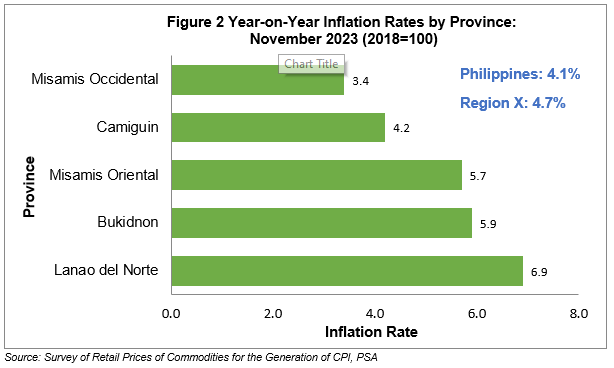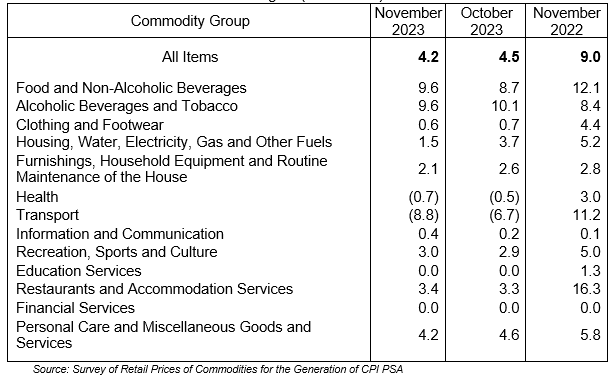Inflation Rate in Camiguin Decelerated Further to 4.2%
The inflation rate in the province of Camiguin continued its deceleration, easing to 4.2 percent in November 2023 from 4.5 percent in October 2023. This development contributes to the province's year-to-date inflation, which now stands at 6.5 percent. (Table A and Figure 1)

Moreover, among the five provinces in Northern Mindanao, only Lanao del Norte experienced a slight increase of 0.2 percentage points, rising from 6.7 percent in October to 6.9 percent in November. In contrast, Misamis Occidental recorded the lowest inflation rate at 3.4 percent, reflecting a decrease of 1.6 percentage points from the previous month.
Furthermore, in November 2023, Camiguin, Misamis Oriental, and Bukidnon also posted lower inflation rates at 4.2 percent, 5.7 percent, and 5.9 percent, respectively. These figures mark a decline from their inflation rates in October 2023, which stood at 5.8 percent, 7.3 percent, and 8.3 percent, respectively. (Figure 2)
Figure 2 presents the annual inflation rates of the provinces in Region X in November 2023.

The province's lower inflation rate was primarily driven by a notable reduction in the housing, water, electricity, gas, and other fuels category, dropping from 3.7 percent in October to 1.5 percent in November. This represents a significant 2.2 percentage points decrease within the month. Additionally, various other groups also saw a decline in their annual inflation rates during November 2023:
• Alcoholic beverages and tobacco, 9.6 percent, from 10.1 percent;
• Clothing and footwear, 0.6 percent, from 0.7 percent;
• Furnishings, household equipment and routine maintenance of the house, 2.1 percent, from 2.6 percent;
• Health, -0.7 percent, from -0.5 percent;
• Transport, -8.8 percent, from -6.7 percent;
• Personal care and miscellaneous goods and services, 4.2 percent, from 4.6 percent;
In comparison, higher inflation rates in several indices were observed. Notably, Food and non-alcoholic beverages experienced a rise to 9.6 percent, marking a 0.9 percentage point increase from the previous month. Similarly, the indices for Information and communication increased to 0.4 percent, up by 0.2 percentage points compared to October. Other commodities registering higher inflation rates in November 2023 include Recreation, sports, and culture at 3.0 percent and Restaurants and accommodation services at 3.4 percent. Meanwhile, the financial and education services indices retained a zero percent annual inflation rate during the same period. (Table 1)
Table 1 Year-on-Year Inflation Rates by Commodity Group:
Camiguin (2018 = 100)

The deceleration in the housing, water, electricity, gas, and other fuels in November 2023 was primarily driven by a reduced monthly inflation rate in Maintenance, repair, and security of the dwelling, which decreased by 1.1 percent. On the other hand, the continued decline in the inflation rate of Transport was influenced by a lower monthly inflation rate in the operation of personal transport equipment, decreasing by 2.0 percent. Furthermore, the decreased inflation rate in Furnishings, household equipment, and routine maintenance of the house was impacted by a 1.4 percent decrease in furniture and furnishings, and loose carpets.
In contrast, the increased inflation in the food and non-alcoholic beverages was primarily attributed to an accelerated monthly inflation rate in cereals which accounted for 6.3 percent, while rice and corn both contributed 7.7 percent.
(SGD)FRANCISCO C. GALAGAR JR.
Chief Statistical Specialist
Technical Notes
This Special Release presents the results of the Survey of Retail Prices of Commodities and Services for the Generation of Consumer Price Index (CPI) conducted in July 2023.
CPI
The CPI is an indicator of the change in the average retail prices of a fixed basket of goods and services commonly purchased by households for their day-to-day consumption relative to a base year.
Uses of the CPI
As an indicator, the CPI is most widely used in the calculation of the inflation rate and purchasing power of the peso. It is a major statistical series used for economic analysis and as monitoring indicator of government economic policy.
The CPI is also used as a deflator to express value series in real terms, which is, measuring the change in actual volume of transactions by removing the effects of price changes. Another major importance of the CPI is its use as basis to adjust wages in labor management contracts as well as pensions and retirement benefits. The CPI also serves as inputs in wage adjustments through the collective bargaining agreements.
Components of the CPI
a. Base Period This is a reference date or simply a convenient benchmark to which a continuous series of index numbers can be related. Since the CPI measures the average changes in the retail prices of a fixed basket of goods, it is necessary to compare the movement in previous years back to a reference date at which the index is taken as equal to 100.
The present series uses the 2018 as the base year. The year 2018 was chosen as the base year because it is the year when the Family Income and Expenditure Survey (FIES) was conducted. The FIES is the basis of the CPI weights.
b. Market Basket
Market basket refers to a sample of thousands of varieties of goods purchased for consumption and services availed by the households in the country. It was selected to represent the composite price behavior of all goods and services purchased by the consumers.
c. Weighting System
The weighting system is a desirable system that considers the relevance of the components of the index. For the CPI, the weighting pattern uses the expenditures on various consumer items purchased by households as a proportion to total expenditures.
d. Geographic Coverage
CPI values are computed at the national, regional, and provincial levels, and for selected cities. A separate CPI for NCR is also computed.
e. Classification Standards The 2012-based CPI series is the first in the series that used the 1999 United Nations Classification of the Individual Consumption According to Purpose (COICOP) in determining the commodity groupings of the items and services included in the market basket. The 2018-based CPI also follows the 2015 Philippine Standard Geographic Classification codes.
Inflation Rate
The inflation rate (IR) is the annual or monthly rate of change of the CPI in percent. It is interpreted in terms of declining purchasing power of money.

